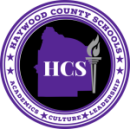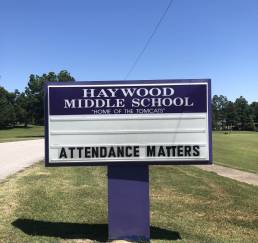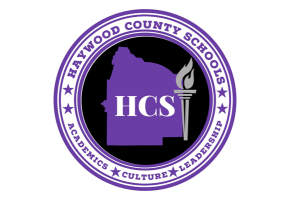Data Dive – HMS
Throughout the school year, students at each school in Haywood County Schools are assessed three times in order to gauge where each individual student is on their personal learning journey. These assessments allow teachers to monitor student learning progress while also gaining insight into what specific areas of a subject a student could use extra support.
While teachers, schools, and districts are measured mostly on TNReady data, the benchmark assessments given throughout the year provide a more accurate view at the learning taking place in the classroom. The assessments used to measure learning in each school in HCS are the AimsWeb assessments in Reading and Math and the IReady assessments in the same subjects. The AimsWeb assessment is given in Kindergarten through Tenth Grades. The IReady assessment is given in grades K-8.
The AimsWeb assessments in Reading and Math measure basic skills in each subject. Basic skills include reading comprehension and fluency and making calculations of measurements, sizes, and amounts. AimsWeb is an assessment that is used to monitor progress and ensure the majority of our students at each grade level are working toward basic grade level skills in each subject.
The IReady assessment measures student progress in relation to state academic standards. This assessment is not always reflective of the basic skills of students in Reading and Math, but shows how well students understand the standards being taught. State standards are created in order to push the students to think at a deeper level beyond the basic skill levels of a subject. These tests combine test taking skills with in-depth knowledge of each subject. This assessment is more closely aligned with the year-end TNReady standardized tests given each spring.
Over the next two weeks, HCS will be sharing grade level data from each school that shows the results from AimsWeb, IReady, and the TNReady assessments. The TNReady assessment is given in grades 2-8.
At the beginning of the year, each school sets a goal based on the fall benchmark. In the horizontal graphs below, results from the fall, winter, and spring benchmark assessments will be shown and compared with the goals set from each school
Students at Haywood Middle School (HMS) showed substantial growth throughout the year on AimsWeb benchmark assessments. On three of four total AimsWeb assessments, HMS students surpassed the goals set at the beginning of the year.
AimsWeb – Haywood Middle School
AimsWeb uses a three tiered system to measure student progress and provide information regarding where students are on their learning paths. While we want all students to be in Tier 1, a more realistic goal (especially coming on the heels of two fractured years of in-person learning) is to see substantial growth in our collective group of Tier 1 students. The tiers are described below:
Tier 1 = Low Risk (about 75%–95% of students in this group will meet the target): Students are on track to meet the end-of-year target and are least likely to need intervention. These students should continue to receive the general instructional program. Typically, the majority of students fall into this category.
Tier 2 = Moderate Risk (about 25%–65% of students in this group will not meet the target): Students are not on track and have a moderate risk of not meeting the end-of-year target. These students require some type of intervention, often taking the form of supplemental small group instruction.
Tier 3 = High Risk (about 50%–90% of students in this group will not meet the target): Students are not on track and are typically well-below grade level. These students have a high risk of not meeting the end-of-year target without intensive, individualized instructional intervention.
The full AimsWeb reports are below.
7th Grade – Reading
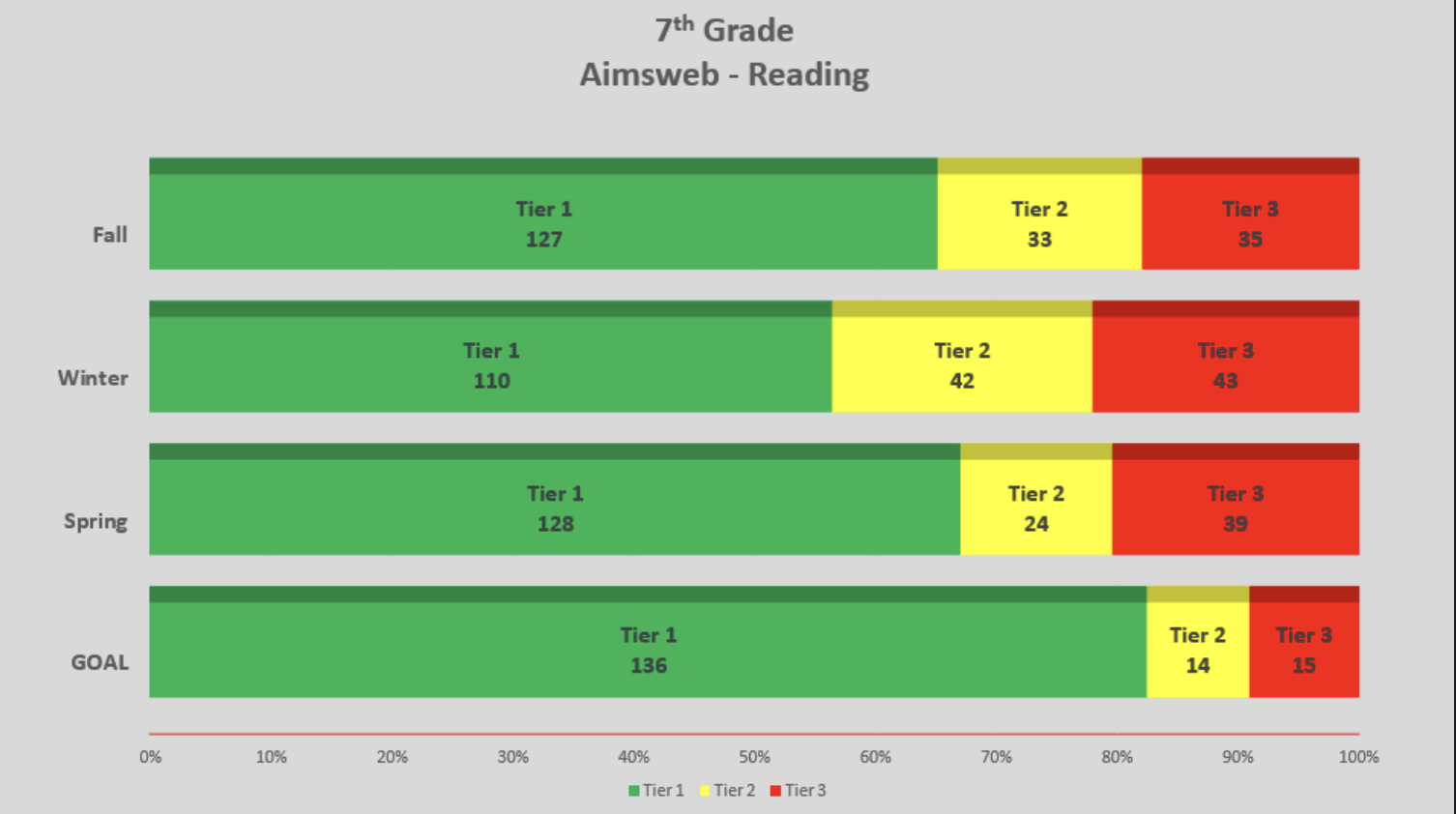
Seventh grade students at HMS started out the year strong on the AimsWeb reading assessment. After the first benchmark test, 65% of students were in Tier 1 with only 18% finding themselves in Tier 3.
After the first benchmark test, however, students regressed, but eventually found themselves essentially where they were at the beginning of the year after the final benchmark assessment in the spring.
Tier 1 students only increased by one, but Tier 3 students increased by six.
7th Grade – Math

While HMS seventh grade students didn’t show much growth on reading, they absolutely showed outstanding progress in math throughout the year.
At the beginning of the year, there were 66 students in Tier 1 which made up about 37% of the grade. By the end of the year, Tier 1 students increased to 134 making up over 70% of the grade!
Tier 3 students were reduced from 93 at the beginning of the year to only 37 by the end of the year.
HMS seventh grade students smashed their goal of having 80 Tier 1 students by 54!
8th Grade – Reading

Eighth grade HMS students surpassed their goal of Tier 1 students by a total of 24 students. By the end of the year, nearly 80% of eighth grade students were in Tier 1 on the AimsWeb reading assessment.
The number of Tier 3 students fell from 50 to 29 from the fall benchmark to the spring benchmark.
8th Grade – Math

Eighth grade students showed exceptional gains in math by increasing their Tier 1 students from 75 in the fall to an impressive 131 students by the spring.
By the end of the year, 70% of eighth grade math students were in Tier 1 on AimsWeb as opposed to only 40% being in Tier 1 at the beginning of the year.
Tier 3 students were reduced from 73 to only 33 by the end of the year.
IReady – Haywood Middle School
IReady data is broken down into five sub-groups and is an assessment that compares well with the TNReady assessment based on the style of questions that are asked. Here is how the scoring is broken down:
Mid/Above grade level: this group is made up of students who are proficient or mastering the grade level educational standards being taught.
Early on grade level: this group is made up of students who are on track to mastery or proficiency of the grade level subject being taught.
1 grade below: this group of students is one grade behind their current grade level as it pertains to the standard being taught.
2 grades below: this group of students is two grades behind their current grade level as it pertains to the standard being taught.
3 grades below: this group of students is three grades or more behind their current grade level as it pertains to the standard being taught.
7th Grade – Reading
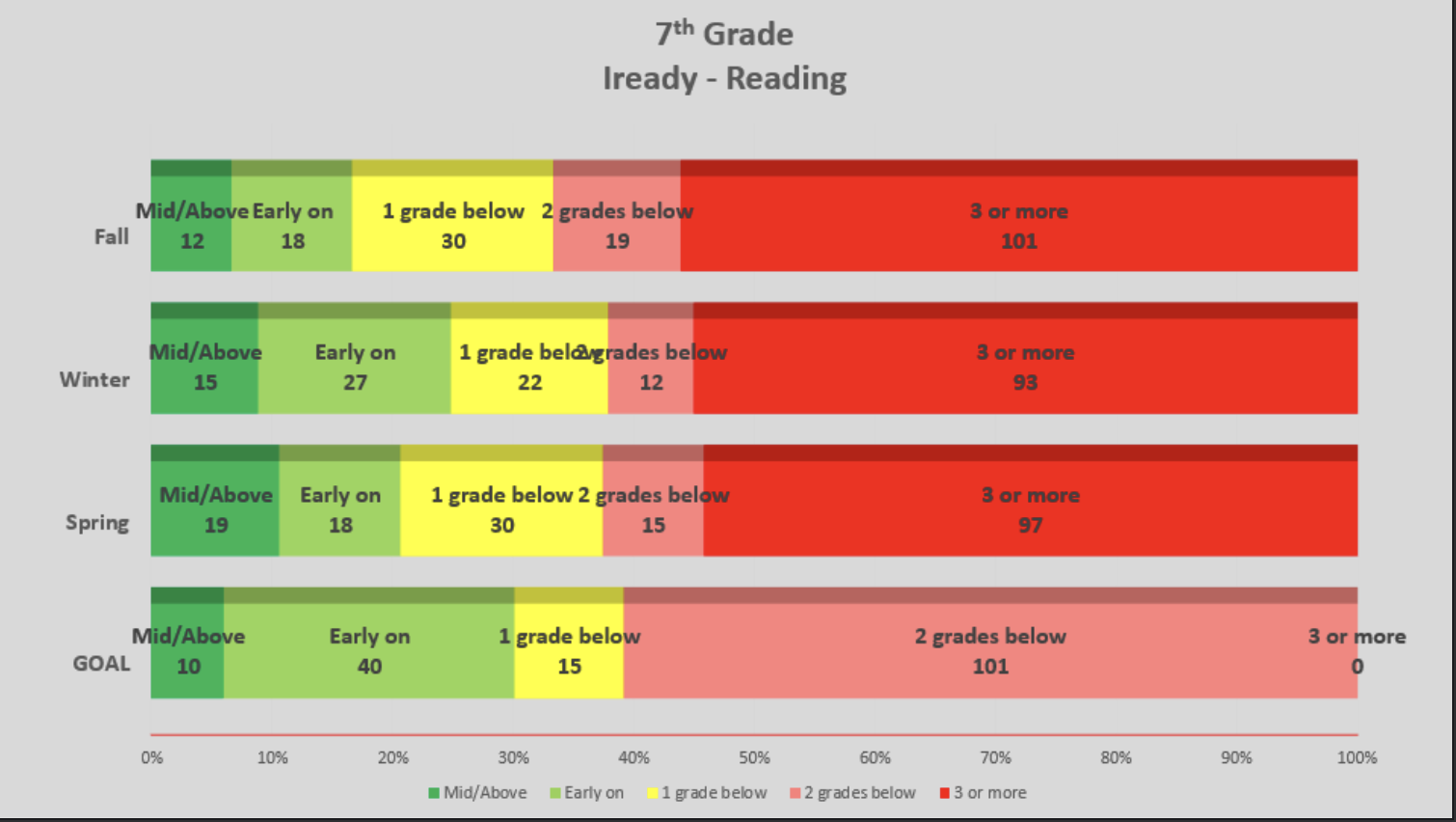
Much like the final data on AimsWeb, seventh grade students’ growth on the IReady reading assessment was static.
On or above grade level students increased from 30 to 37 over the course of the year, while the number of students who were three or more grade levels below decreased by only four.
7th Grade – Math
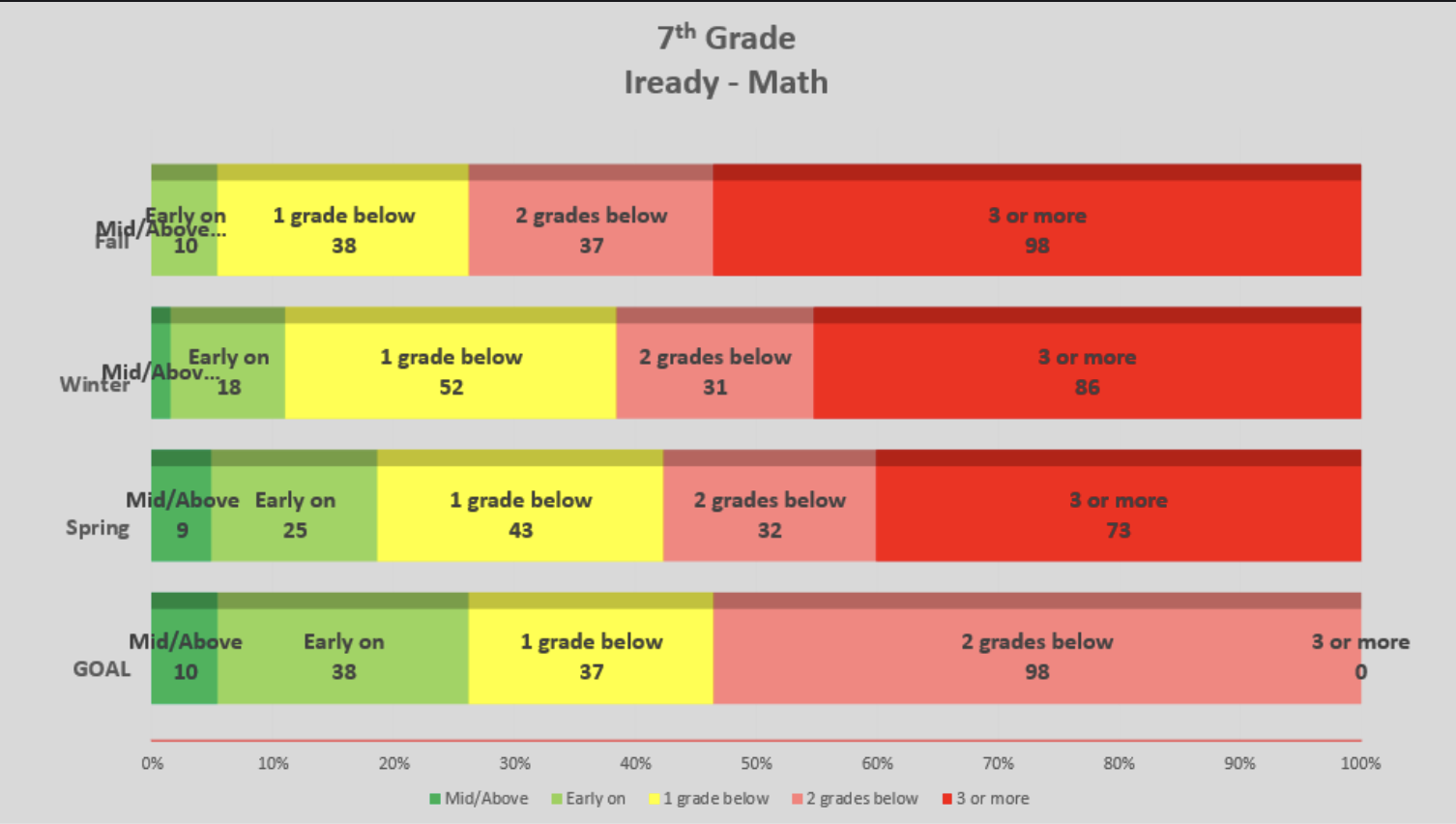
Seventh grade students saw encouraging gains throughout the year in math as they increased their number of on and above grade level students as well as decreased their number of students who were below grade level.
In the fall, there were only ten students who were on or above grade level, but by the spring there were 34.
Students two grades below grade level decreased from 37 to 32. Students three grades below grade level decreased from 98 to 73.
8th Grade – Reading
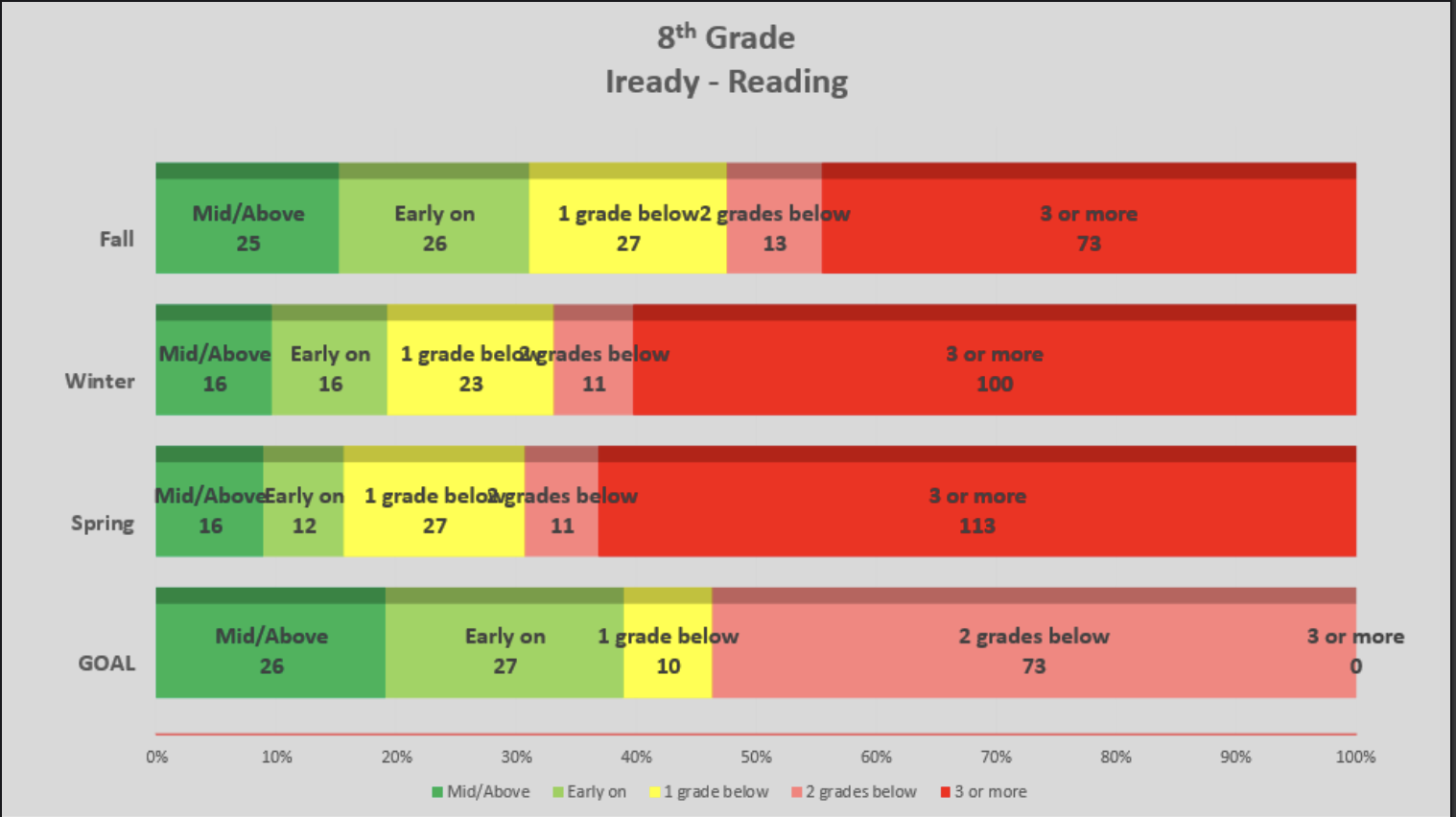
Eighth grade students saw a drop in IReady performance over the course of the year.
At the beginning of the year, 51 students were on or above grade level. However, by the end of the year, 28 students were on or above grade level.
The number of students three or more grade levels below rose from 73 to 113.
This data is concerning, but also doesn’t line up with AimsWeb data the way other schools’ IReady data lined up.
There are quite a few variables to this data; the main variable being that students took the spring IReady assessment after they took the TNReady assessment. The TNReady assessment gets most of the students’ focus at the end of the year and is the assessment on which schools and districts are evaluated. Any assessment given after TNReady can feel less important.
8th Grade – Math
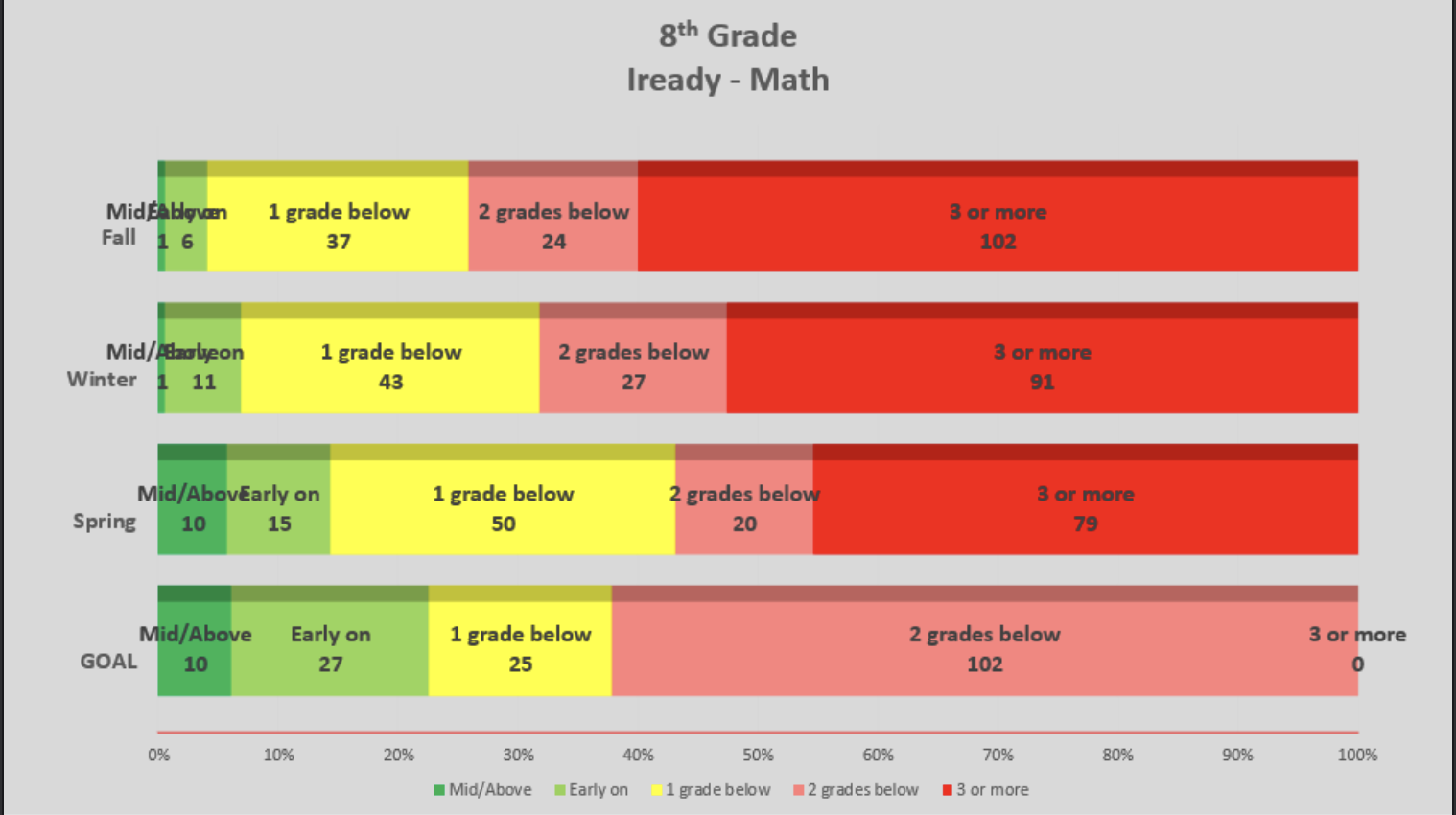
Data from the eighth grade students on the Math IReady assessment showed consistent growth throughout the year.
Students who were on or above grade level rose from seven to 25 by the end of the year. Students who were two or more grades below shrank from 126 to 99. That’s definite progress.
TNReady/TCAP Data – Fifth/Sixth Grade
The TNReady/TCAP assessments at the end of each year are the assessments that get weighed heaviest when it comes to learning data for schools and districts.
The TNReady/TCAP assessments measure how well students understand the state educational standards that are taught during the school year; this assessment does not measure basic, fundamental skills in academic subjects. While the data is clearly valuable, it does not always paint an accurate picture of a student’s reading level or basic understanding of mathematical concepts.
Below are the data from HMS seventh and eighth grade students on the TNReady/TCAP assessments. The data is broken down by subject and test – ELA, Math, Science, and Social Studies.
The data is broken down into four groups – mastery, on track, approaching, and below.
Mastered: Performance at this level demonstrates that the student has an extensive understanding and expert ability to apply the grade/course level knowledge and skills defined by the Tennessee academic standards.
On Track: Performance at this level demonstrates that the student has a comprehensive understanding and thorough ability to apply the grade/course level knowledge and skills defined by the Tennessee academic standards.
Approaching: Performance at this level demonstrates that the student is approaching understanding and has a partial ability to apply the grade/course level knowledge and skills defined by the Tennessee academic standards.
Below: Performance at this level demonstrates that the student has a minimal understanding and has a nominal ability to apply the grade/course level knowledge and skills defined by the Tennessee academic standards.
7th Grade TNReady/TCAP Data
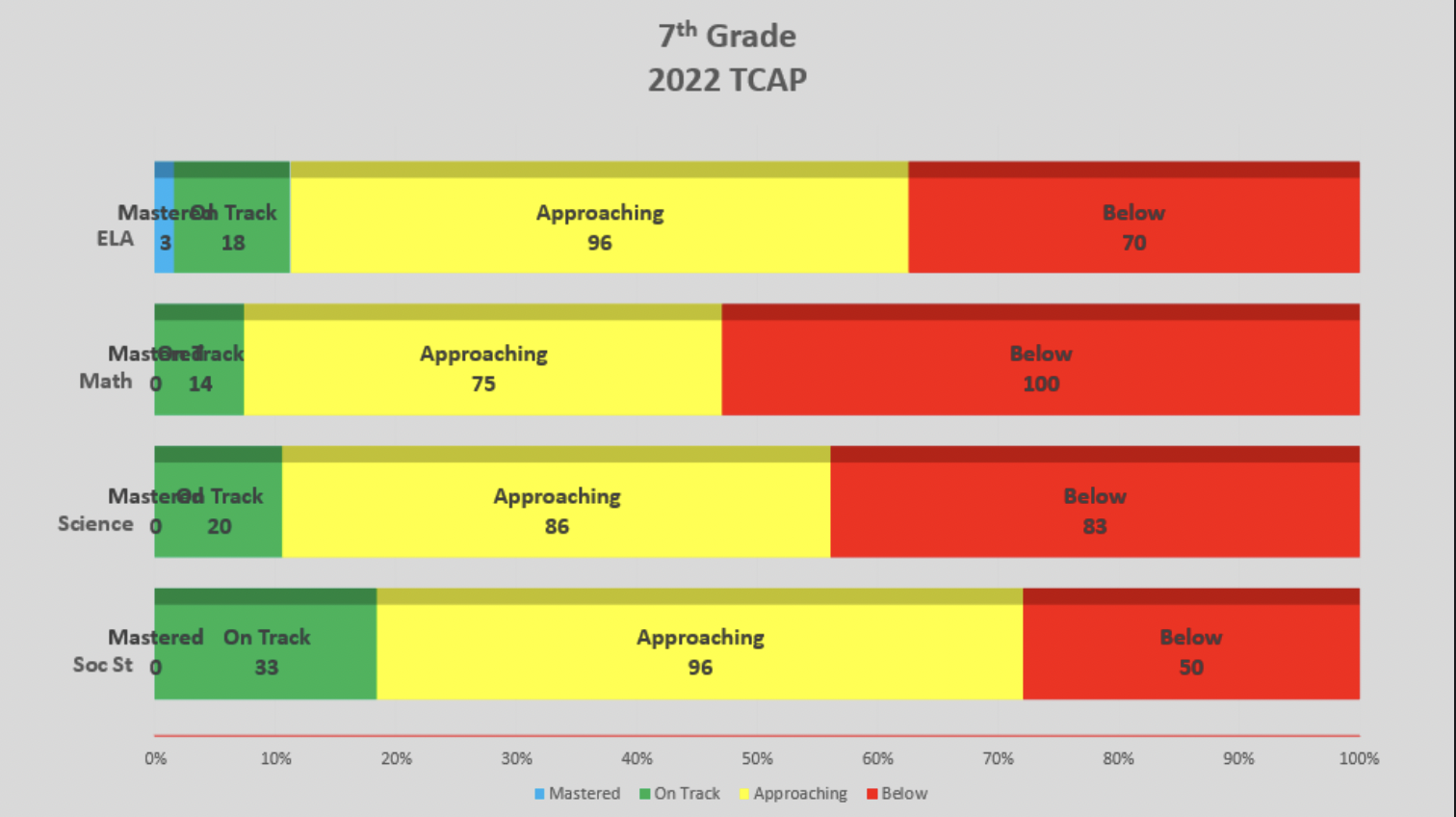
ELA – 21 students mastered or were on track on the ELA portion of the TCAP assessment. 96 students were approaching grade level. Nearly 70% of 7th grade students were on or approaching grade level in ELA.
Math – 14 students were on track and 75 students were approaching grade level. Roughly 50% of students were on track or approaching with the other half of the grade below grade level.
Science – 20 students were on track and 86 students were approaching grade level. Nearly 60% of 7th grade students were either approaching or on grade level in Science.
Social Studies – 33 students were on track and 96 students were approaching grade level. That accounted for close to 75% of the seventh grade on track or approaching grade level.
8th Grade – TNReady/TCAP
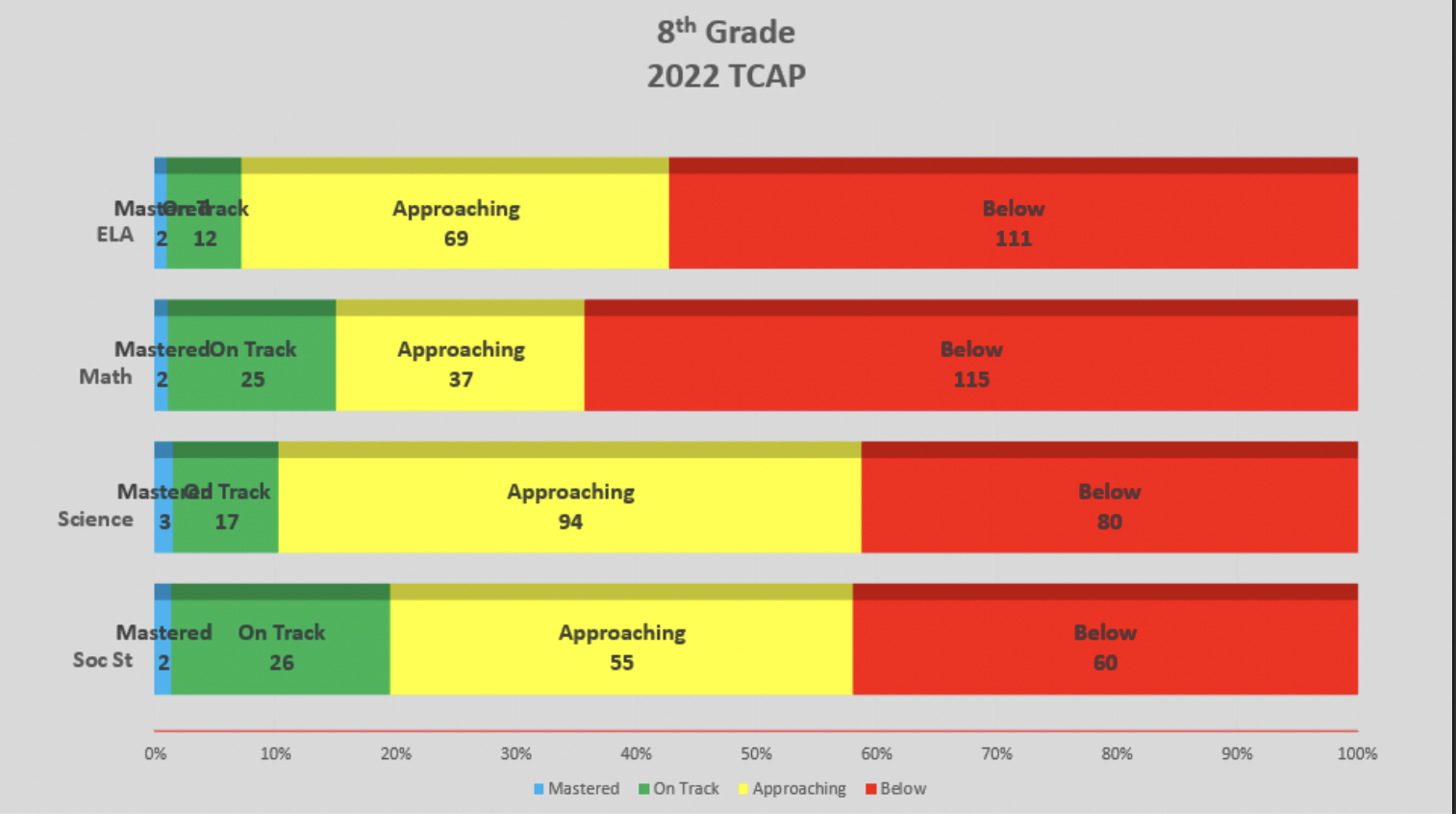 ELA – 14 students were on track or mastered with 69 students approaching grade level. This made up 45% of the grade with the remaining 55% below grade level.
ELA – 14 students were on track or mastered with 69 students approaching grade level. This made up 45% of the grade with the remaining 55% below grade level.
Math – 27 students were on track or mastered with 37 approaching. This made up nearly 40% of the grade level with the remaining 60% below grade level.
Science – 20 students were on track or mastered with 94 students approaching grade level. This made up 60% of the grade with the remaining 40% below grade level.
Social Studies – 28 students were on track or mastered with 55 approaching grade level. This made up nearly 60% of the grade with the remaining 40% below grade level.
While there were some pieces of data that were concerning, students did show learning growth throughout the school year and the majority of our HMS students improved as the year progressed.
